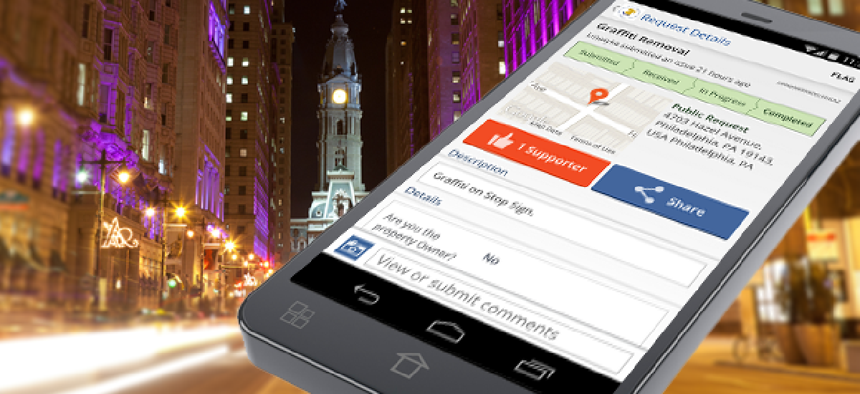Revamped Philly 311 goes social


Connecting state and local government leaders
Based on Salesforce’s cloud platform, the new Philly 311 system expands residents’ access to city services, lets them view other nearby inquiries and helps the city better track service requests.
A new blueprint for handling Philadelphia’s open 311 services passes some of the power over city services to residents.
Announced Feb. 18 at the city’s first Citizen Engagement Innovation Summit, the new Philly 311 system updates what’s been in place since 2008 with some notable additions, including a cloud-based neighborhood portal that lets residents view nearby requests, organize events to address their concerns and helps the city better track service requests.
“We’re moving towards a model where the government doesn’t have to provide all the solutions, but it can be a platform upon which citizens are able self-organize,” said Vivek Kundra, executive vice president of Salesforce, a cloud computing company. “What you’re seeing is a huge shift. Philly 311 is the customer service tool, the front office for the city of Philadelphia.”
And that front-office focus is crucial, he added. “For the last 40 years we’ve seen massive investments in [information technology] that, frankly, have not paid off, which were all in the back office,” said Kundra, former chief information officer of the United States. “Now what you’re seeing in terms of the cities is that they’re making these investments in the front office and addressing the problems that citizens actually have.”
Since the Philly 311 Call Center opened in 2008, it has received more than 7 million calls from citizens and businesses with service requests, ranging from pothole repairs and cleaning graffiti to removing drug paraphernalia from playgrounds and reporting abandoned vehicles, the city said.
Philly 311 expands citizens' access to city services via a wide range of channels including telephone, Internet, the Philly 311 mobile app and Facebook and Twitter. The system also provides comprehensive service reporting capabilities to city management on system performance and geographic-based service needs, according to Unisys, which set up the system.
With the portal, residents don’t have to wait for government workers to respond. Instead, they can interact with one another on concerns about, say, drug use, graffiti or crime in a particular section of the city. For instance, if people want to build a playground, they can organize an event via the portal, according to a CBS Philly report in which city Chief Customer Service Officer Rosetta Carrington Lue described the portal as “kind of like Facebook for government.”
Other new features of the app include better mapping to geolocate problems and improved tracking for service requests. Predictive analytics will also be used to anticipate residents’ needs, such as scheduling trash pickup ahead of a snow storm, Kundra said.
The new Philly 311 is built on Salesforce’s government customer relationship management (CRM) cloud computing platform. It was part of a $120 million capital investment by Mayor Michael Nutter to upgrade technology infrastructure and part of his Philly Innovates Blueprint, a seven-step plan for making America’s fifth largest city more connected. Since the new app was first released in 2012, it’s become the second most used tool for logging service requests and has a 93 percent customer satisfaction rating, the blueprint states.
Since then, Philadelphia has seen the number of people who walked into a city government building to request services drop by 30 percent, while the number who used mobile as the point of contact rose 344 percent, according to Salesforce statistics.
“With the new Philly 311 customer service platform, our goal is not only to create a more connected, citizen-responsive city, but also to inspire other cities to follow our model and engage their citizens,” Nutter said in a statement.
Nationwide, he said, three big forces that are “fundamentally changing the way governments around the country, around the world, have to confront the future.”
The first is that companies such as Airbnb, Uber and ZocDoc have revolutionized how people rent homes, move throughout a city and make doctor appointments, resetting people’s service expectations. As a result, he said, it’s no longer acceptable to make people wait in line to submit paper forms, for example.
The second factor is the way social media, mobile, cloud and big data technologies are accelerating that transformation, Kundra said.
The final piece is a fundamental shift in power is occurring from government officials to city residents. “The old debate about big government or small government is over,” he said. “It’s about smart government. How do you make sure that you’re putting citizens at the heart of government operations, and how do make sure that you’re using these technologies to actually restore trust in government, to be more transparent, open and participatory?”
“It’s much bigger than just a technology story. It’s about redefining the business model of government,” Kundra added.
NEXT STORY: What’s on Microsoft’s 2015 enterprise roadmap




